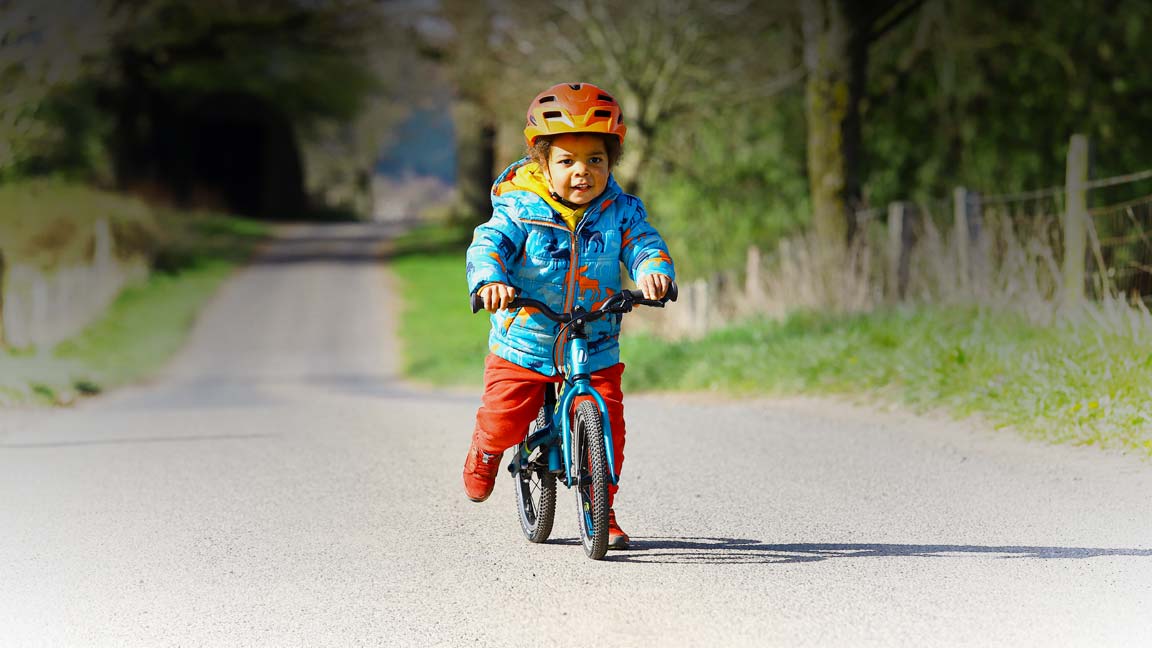Learning to ride a balance bike

Balance bikes are the perfect introduction to cycling for very young children. Most children don’t develop the coordination necessary to ride a bicycle with pedals until somewhere between the ages of 3 ½ and 4 ½ years old, but many children can balance and scoot on two wheels from the age of 2. Using a balance bike makes the learning process easier by breaking it into two parts, enabling the child to develop and master their balance and steering skills at an earlier age before moving onto a starter bike to learn pedalling when they are ready, usually without the need for stabilisers.
Where
Find a suitable location – a safe, flat, or nearly flat open space that allows your budding cyclist to wobble at will is ideal. Choose tarmac or very short firm grass; longer or softer grassy surfaces will hinder momentum and balance.
We have recently invented cycling, so, unlike walking, the motion is not hardwired into children – if they’ve never seen someone on a bike, they won’t know what they are trying to do. Having other children around cycling or using balance bikes, such as a public park or play area, really helps them grasp what is required.
Technique
Make sure your child is wearing closed toed shoes.
Adjust the saddle height so that your child can get both feet flat on the floor with enough bend at their knees to allow them to still contact the ground when reaching forward to stride.
Help your child to get on the bike and wrap their hands around the grips.
If necessary, lightly support your child by holding them under the armpits – if they begin to fall you can then simply lift them up. Don’t be tempted to hold onto the handlebars as this interferes with the steering action.
Your child will typically begin by walking with the bike, waddling along and possibly standing and pushing rather than sitting in the saddle. As confidence grows they will begin to walk the bike along from a sitting position whilst learning how the bike responds to leaning. Often this is as far as they get to begin with, but over time their strides get longer and more confident until eventually they are lifting their feet momentarily between strides, and this is when they begin to properly master balance. Eventually, as they become proficient, they can move really quickly and you’ll have to run to keep up!
It is usually not helpful to introduce the use of the brake initially, as it is a distraction from learning to scoot and they won’t be going fast enough to need it. Once they are underway, show them how it works while they are stationary and get them to use it a few times whilst going along slowly, so they can get the hang of it before applying it at higher speeds.
Age
The age at which a child develops the potential to be able to balance and scoot, or balance and pedal, varies enormously. They simply can’t learn to ride until these developments are in place, any more than they can learn to walk before they are ready, so try and avoid the temptation to “teach” them if its obvious they aren’t ready yet. Some children can learn to ride a balance bike at 2, but many aren’t ready until they are at least 3. If your child isn’t ready, do other things and try again in a few weeks or months – its clear when they are ready as they’ll then progress quite quickly.
A note on stabilisers
We don’t recommend stabilisers as the best way to learn to ride a bike for most children – see our video here for tips on helping your child learn to ride. A bicycle steers by leaning, and stabilisers prevent that, putting off the point of learning until you remove them, at which point learning can be harder as incorrect habits have to be unlearned. We have found that a child that has previously ridden with stabilisers will take longer to learn to ride without than a one who has never ridden a bicycle before. If its clear your child isn’t ready to learn without yet, better to wait until they are (if you can!) than fit stabilisers.
